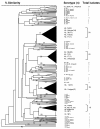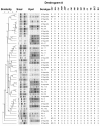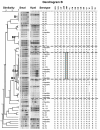PFGE, Lior serotype, and antimicrobial resistance patterns among Campylobacter jejuni isolated from travelers and US military personnel with acute diarrhea in Thailand, 1998-2003
- PMID: 21062505
- PMCID: PMC2989297
- DOI: 10.1186/1757-4749-2-15
PFGE, Lior serotype, and antimicrobial resistance patterns among Campylobacter jejuni isolated from travelers and US military personnel with acute diarrhea in Thailand, 1998-2003
Abstract
Background: Campylobacter jejuni is a major cause of gastroenteritis worldwide. In Thailand, several strains of C. jejuni have been isolated and identified as major diarrheal pathogens among adult travelers. To study the epidemiology of C. jejuni in adult travelers and U.S. military personnel with acute diarrhea in Thailand from 1998-2003, strains of C. jejuni were isolated and phenotypically identified, serotyped, tested for antimicrobial susceptibility, and characterized using pulsed-field gel electrophoresis (PFGE).
Results: A total of 312 C. jejuni isolates were obtained from travelers (n = 46) and U.S. military personnel (n = 266) in Thailand who were experiencing acute diarrhea. Nalidixic acid and ciprofloxacin resistance was observed in 94.9% and 93.0% of the isolates, respectively. From 2001-2003, resistance to tetracycline (81.9%), trimethoprim-sulfamethoxazole (57.9%), ampicillin (28.9%), kanamycin (5.9%), sulfisoxazole (3.9%), neomycin (2.0%), and streptomycin (0.7%) was observed. Combined PFGE analysis showed considerable genetic diversity among the C. jejuni isolates; however, four PFGE clusters included isolates from the major Lior serotypes (HL: 36, HL: 11, HL: 5, and HL: 28). The PFGE analysis linked individual C. jejuni clones that were obtained at U.S. military exercises with specific antimicrobial resistance patterns.
Conclusions: In summary, most human C. jejuni isolates from Thailand were multi-resistant to quinolones and tetracycline. PFGE detected spatial and temporal C. jejuni clonality responsible for the common sources of Campylobacter gastroenteritis.
Figures





References
-
- Bodhidatta L, Vithayasai N, Eimpokalarp B, Pitarangsi C, Serichantalergs O, Isenbarger DW. Bacterial enteric pathogens in children with acute dysentery in Thailand: increasing importance of quinolone-resistant Campylobacter. Southeast Asian J Trop Med Public Health. 2002;33:752–757. - PubMed
-
- Friedman CR, Neimann J, Wegener HC, Tauxe RV. In: Campylobacter. 2. Nachamkin I, Blaser MJ, editor. Washington, DC, USA: ASM Press; 2000. Epidemiology of Campylobacter jejuni infections in the United States and other industrialized nations; pp. 121–138.
LinkOut - more resources
Full Text Sources

